TEEB-Russia: Towards National Ecosystem Accounting
Abstract
1. Introduction: TEEB-Russia Project
2. Materials and Methods
2.1. Data Sources, Scales of Analysis, and Data Processing
- public databases of the Federal State Statistics Service (FSSS): “Regions of Russia. Socioeconomic indicators”; “Agriculture, Hunting and Game Management, Forest Management in Russia”;
- the digital cartographic database “Land Resources of Russia” [9];
- data on bird diversity from the Atlas of Breeding Birds of the European part of Russia, collected and managed by the Zoological Museum of Moscow Lomonosov State University [12];
- literature: statistical digests, scientific studies, published maps (National Atlas of Russia, National Atlas of Soils of Russia), etc.
- ecoregions within the European Russia, according to Olson et al. [13];
- subjects of the Russian Federation (RF) as of 2012 (83 subjects);
- squares of 50 × 50 km within European Russia according to the grid used in the Atlas of Breeding Birds of European part of Russia.
2.2. Indicators of Ecosystem Assets Tested in the TEEB-Russia Project
- (1)
- Indicators of the extent of ecosystem assets:
- the degree of anthropogenic transformation of territory assessed by the relative proportions of anthropogenic areas (arable and urban lands) and the complementary indicator of the proportionate share of natural ecosystems. These indicators were also derived from the map of Russia’s vegetation [10,11].
- (2)
- Indicators of the condition of ecosystem assets:
- indicators of fragmentation of natural ecosystems, namely the ratio of the perimeter to the area of plots of natural ecosystems (PAR) and the average distance between plots of natural ecosystems (DISTANCE). Our analysis showed that, at the national scale, these indicators unambiguously correlate with the previously named indicator of territory transformation, i.e., these indicators reflect the same processes at that scale. Therefore, we do not discuss these indicators further here. Fragmentation indicators are likely to be useful at more detailed scales of analysis, e.g., local and, possibly, regional;
- indicators of ecosystem functioning—productivity (net primary production, kgC/m2/yr) and phytomass (total phytomass density, dry matter, kg/m2) of natural ecosystems. For preliminary testing, we used indicators derived from digital maps of productivity/phytomass of typical natural ecosystems from the database “Land Resources of Russia” [9];
- biodiversity indicators—indicators of vascular plant species richness (species number per 100,000 km2 according to the National Atlas of Russia [16] and number of plant species in local flora based on data from O. Morozova [17]), several indicators of bird species richness, level of bird synanthropization and Red Data Book status based on data from the “Atlas of Breeding Birds of European part of Russia” [12] and Red Data Book of Russian Federation (2001) [7].
2.3. Ecosystem Services Considered in the TEEB-Russia Project
- (1)
- Six provisioning ES, i.e., the production of biomass which can be withdrawn by people from ecosystems: wood, non-wood products, fodder from natural pastures, products from freshwater ecosystems (e.g., fish), game products; honey harvested from naturel ecosystems.
- (2)
- 18 regulating (environment-forming) ES, i.e., the creation and the maintenance of environmental conditions favorable to human life and economic development:
- regulation of climate and atmosphere: carbon storage, regulation of CO2 flows; biogeophysical climate regulation; air purification by suburban forests;
- hydrosphere regulation: regulation of runoff volume; regulation of runoff variability; assurance of water quality by terrestrial ecosystems; water purification in freshwater ecosystems;
- soil formation and protection: soil protection from water erosion; soil protection from wind erosion; prevention of soil drift into water bodies; prevention of landslides and mudflows; establishment of soil bioproductivity; soil self-purification; regulation of cryogenic processes;
- regulation of biological processes important for economy and health: ecosystem regulation of economically important species such as agricultural and forests pests; crop pollination by wild pollinators; ecosystem regulation of species important for medicine and veterinary.
- (3)
- Cultural Four cultural ES, i.e., various forms of information contained in natural ecosystems which can be used by people: genetic resources of wild species and populations; information on the structure and functioning of natural systems; aesthetic and educational value of ecosystems; ethical, spiritual, and religious value of ecosystems.
- (4)
- Three recreational ES, i.e., creation and maintenance of natural conditions for various forms of recreation: local daily and weekend recreation; outdoor tourism; recreation in resorts.
- provided ES, i.e., potential ES produced by ecosystems, regardless of the presence or absence of consumers of ES;
- required (demanded) ES, i.e., ES volume needed to meet the needs of the population and the economy of the region; in the projects TEEB-Russia 1 and 2 [6,7], required ES were only estimated for the removal of pollutants from the environment as the volume of pollutants that must be neutralized by ecosystems (annual pollutant emissions were used as a proxy);
- consumed (used) ES, i.e., ES volume that is materially or intangibly used by the population or from which people currently benefit.
- the degree of ES use (Vconsumed/Vprovided × 100% or Vprovided − Vconsumed);
- the potential satisfaction of demand for ES (Vprovided/Vrequired × 100% or Vrequired − Vprovided);
- the actual satisfaction of demand for ES (Vconsumed/Vrequired × 100% or Vrequired − Vconsumed);
- the deficit or excess of the service (Vdemanded − Vsupplied).
2.4. Methods of ES Assessment and Data Processing
- (1)
- Direct quantitative valuation of ES in biophysical terms—when values of supplied, consumed, and demanded ES were given in statistical reports.
- (2)
- Indirect quantitative valuation in biophysical terms—when direct statistical data were lacking but we could make use of cartographic data and previous studies to evaluate the desired indicators based on simple calculations or GIS modeling. Table 1 gives short descriptions of this method for the example of provided ES volumes (for details, see [6,7]).
- (3)
- ES were assigned a score of 1–10 if there were no data to evaluate the ES themselves, and it was only possible to assess natural factors affecting provided/potential ES as well as socio-economic factors impacting required and consumed ES [6]. The difference in the scores of provided and consumed ES reflects the ratio of natural and socioeconomic factors in a region. Negative values indicate that socio-economic factors linked to a high demand for ES and their intensive consumption outweigh natural factors that determine the provision of ES by ecosystems. Positive values indicate that natural factors outweigh socio-economic factors. Zero values indicate a relative balance of factors that determine the provision and use of ES. Figure 2 gives an example of this assessment method for the ES of wild genetic resource storage in natural ecosystems.
| ES | Indicators | Data Sources | Valuation Methods |
|---|---|---|---|
| Fodder production in natural pastures and hayfields 1 | Productivity of natural pastures, (kg/ha/year of fodder units) | Vegetation map of Russia Land Resources of Russia | Determined by the area of grassy ecosystems (potential pastures) and their productivity |
| Air purification by suburban forests 1,2 | Potential absorption of air pollution (dust and gases), kg/ha/year | Vegetation map of Russia Coefficients from literature | Determined by the area of different types of forests in the buffer zones of cities (from 3 to 20 km depending on emission volume and climatic index of air pollution) and absorption indexes for Canadian cities |
| Regulation of runoff volume 1,2 | Runoff provided by terrestrial ecosystems (“ecosystem runoff”), m3/ha/year | Land Resources of Russia | For geographic areas with excess moisture, “ecosystem runoff” equals the difference between surface and hypothetical runoff (hypothetical runoff is the difference between average annual precipitation and average annual evapotranspiration). For geographic areas with normal or insufficient moisture, “ecosystem runoff” equals surface runoff |
| Assurance of water quality by terrestrial ecosystems 1 | Potentially purified runoff, m3/ha/year | Vegetation map of Russia Coefficients from literature | Determined by the area of polluted territories, area of different types of forests, grassy ecosystems, and arable land and the coefficient of preventing surface drift of contaminants |
| Assurance of water quality by freshwater ecosystems 1 | The volume of wastewater potentially diluted and purified to a safe concentration, m3/ha/year | FSSS database Land Resources of Russia Coefficients from literature | Determined by the wastewater volume, surface runoff, and coefficients of biochemical transformations of pollutants in water bodies |
| Prevention of water erosion of soil 2 | Avoided erosion, t/ha | Vegetation map of Russia Coefficients from literature | GIS modeling based on a universal soil loss equation considering landcover, relief, land use, soil, and precipitation indices |
| Regulation of cryogenic processes 1 | Change in surface temperature without vegetation and snow cover, °C | Land Resources of Russia Coefficients from literature | Determined by the climatic conditions, permafrost area, cooling, and heating coefficients of vegetation and snow |
| Providing natural conditions for weekend recreation 2 | Recreational capacity of ecosystems, i.e., the maximum number of permitted visitors with no degradation of ecosystems | Vegetation map of Russia Coefficients from literature | Determined by the ecosystem area in suburban zones (25–50 km depending on city population) and the maximum recreational capacities according to the recommendations of the State Committee on Forestry of USSR |
3. Results
3.1. Data Availability and Suggested Indicators for Ecosystem Accounting
3.2. Importance of Ecosystems and Ecosystem Services of Russia

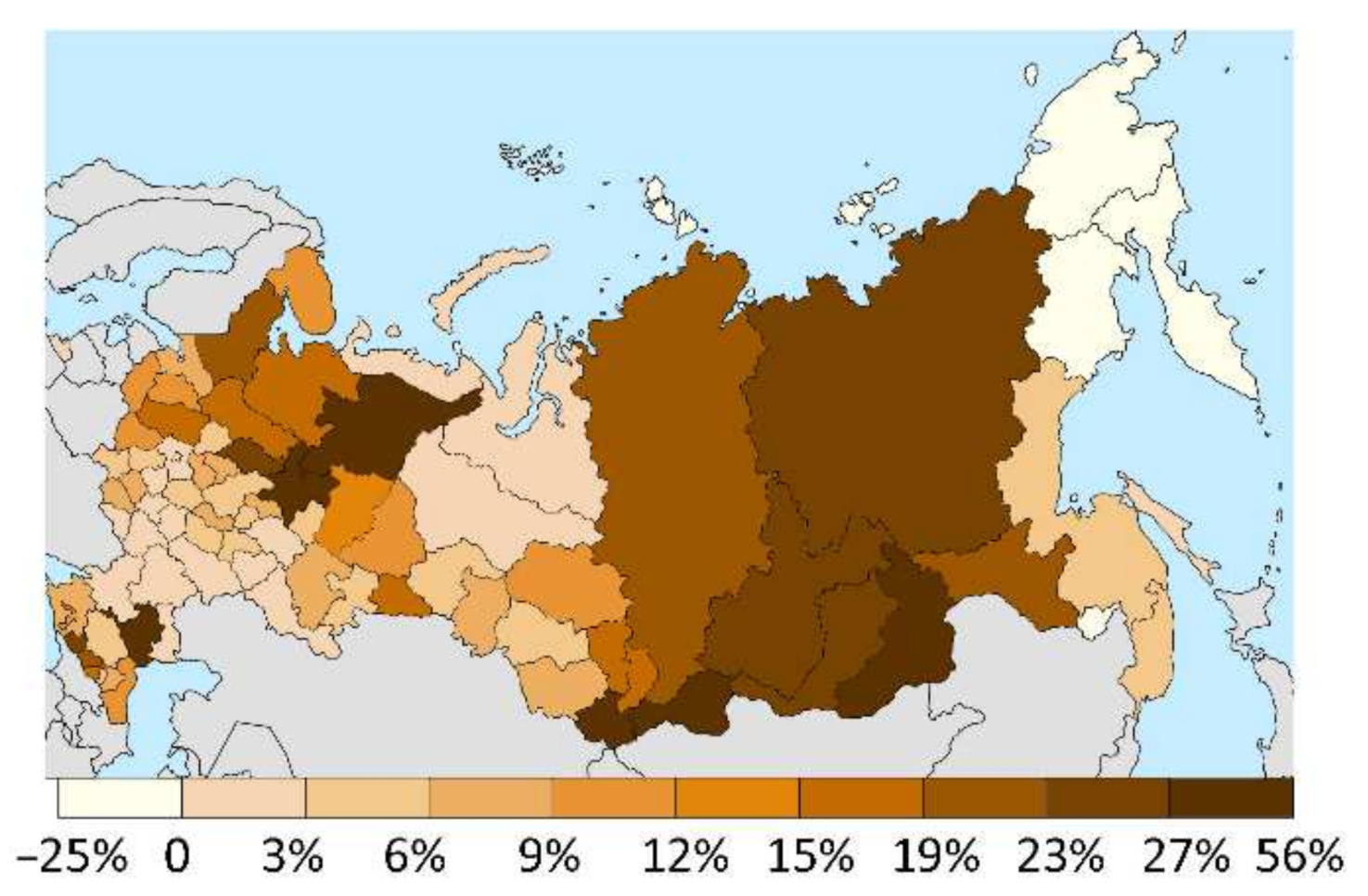
3.3. Comparing ES of Regions
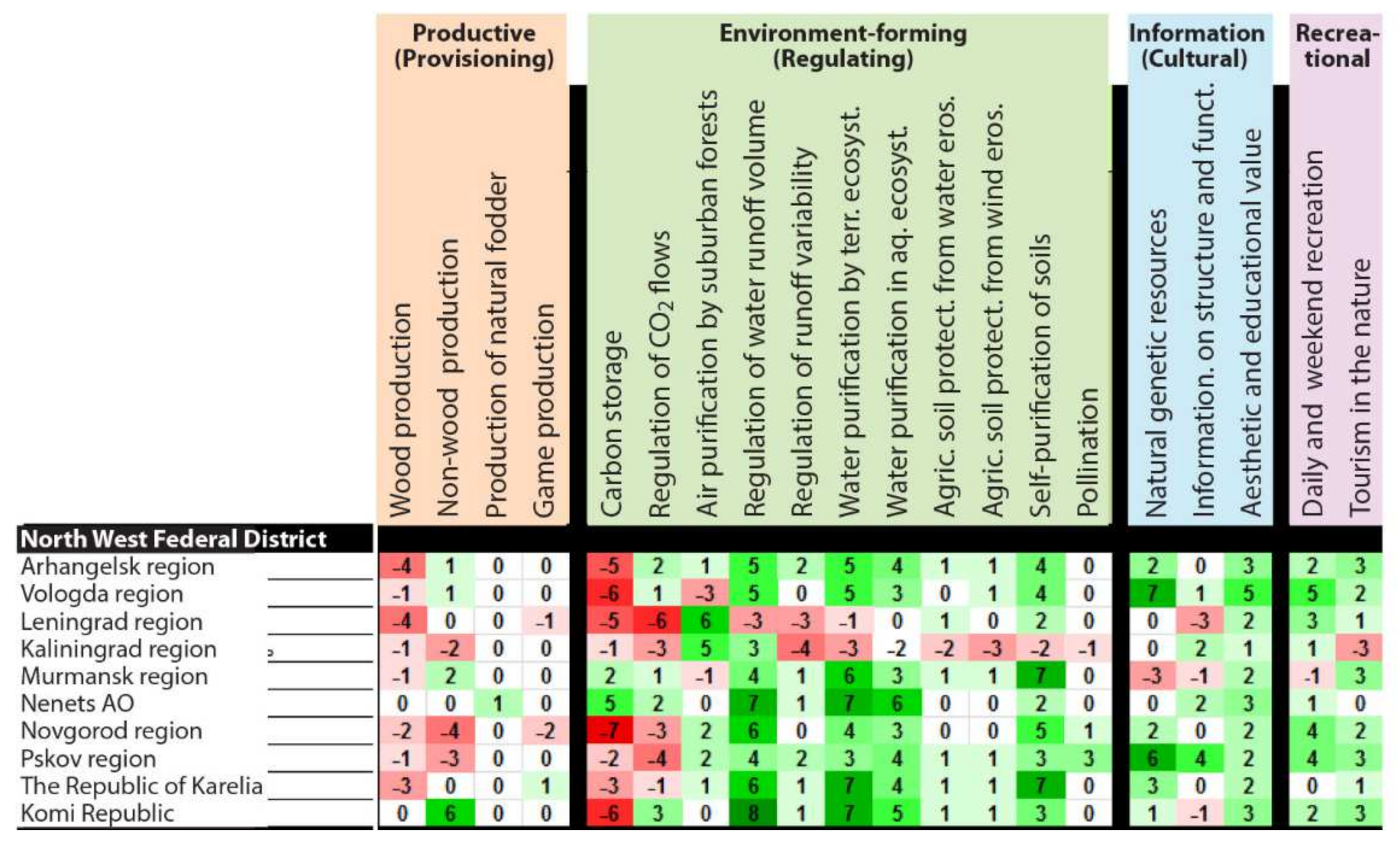
3.4. Relationships between Indicators of Ecosystem Assets and ES
3.5. Regional Differences in Values and Relationships between Indicators of Ecosystem Assets and ES
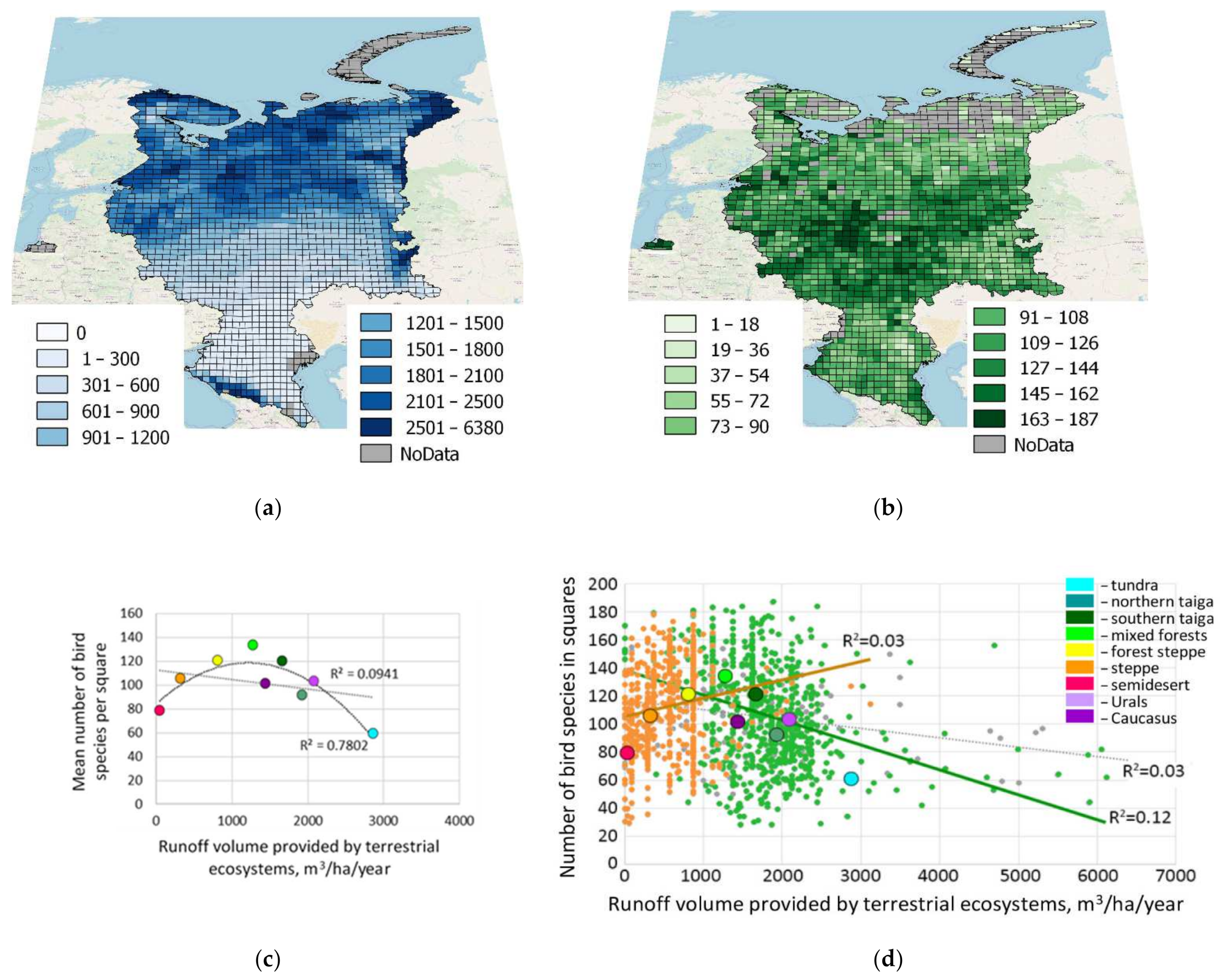


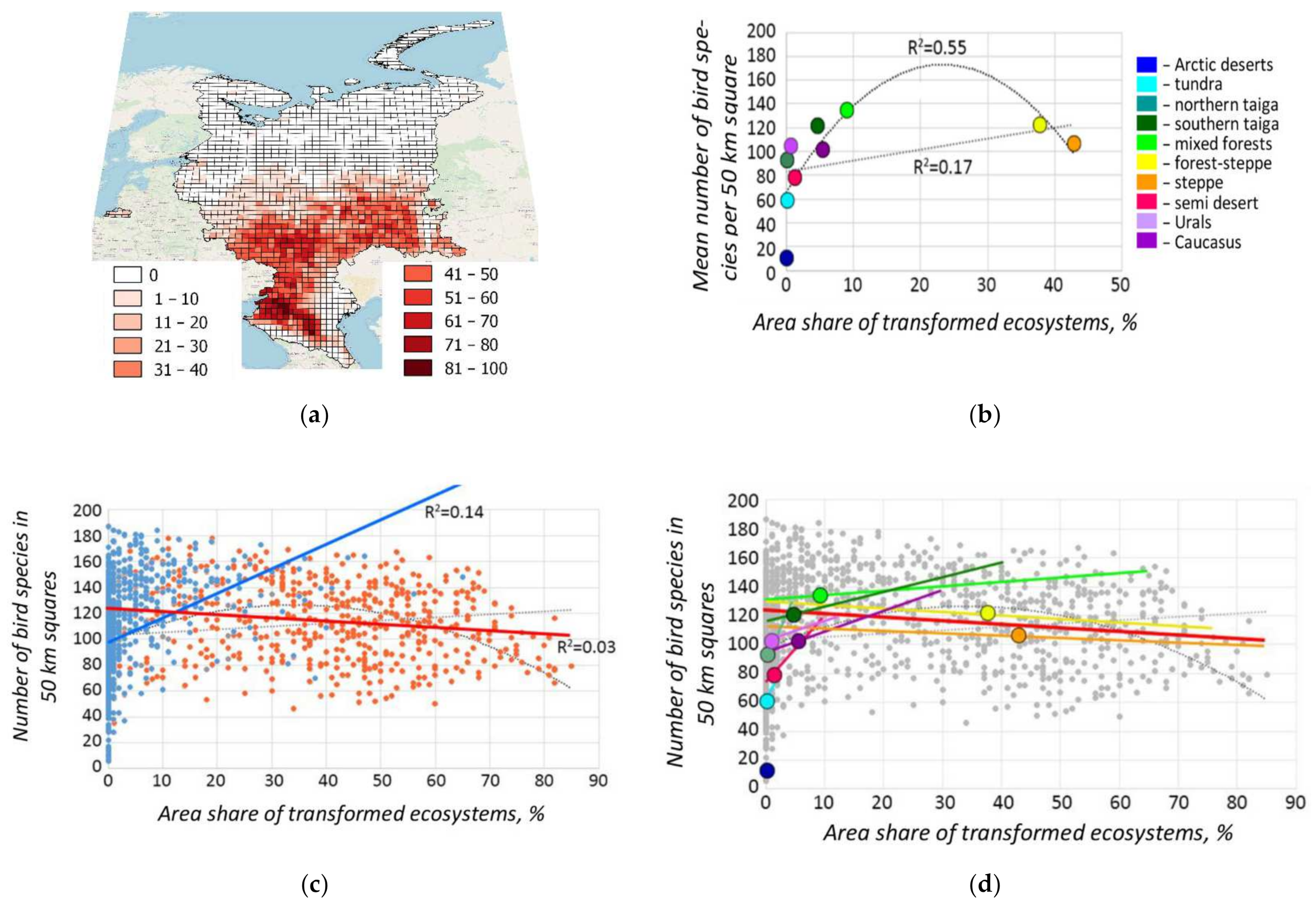
4. Discussion: Implications of the Results of the TEEB-Russia Project for the Organization of Ecosystem Accounting in Russia
4.1. Implications of Results of Biodiversity Indicator Testing
4.2. Regionally Differentiated Approach to Ecosystem Accounting
4.3. Different Management Interpretations of Correlations and Causality
4.4. Consideration of Spatial Scales in Decision Making
4.5. Providing Ecosystem Accounting with Statistical and Cartographic Data
5. Conclusions
- indicators of ES: ES provided by ecosystems (potential ES); ES required by the population and economy; ES consumed by the population and economy; degree of use of ES and satisfaction of demand (determined by the ratios of the provided, required and consumed ES);
- indicators of ecosystem assets: area of ecosystems; productivity and phytomass of ecosystems; indicators of biodiversity—plant and animal species richness, protective status of species (inclusion in red lists).
- ecosystem accounting should be regionally differentiated so as to consider the regional specifics of natural conditions, the degree of anthropogenic transformation of ecosystems, and the socio-economic development of Russia’s regions (Section 4.2, Figure 7c,d; Figure 9c; Figure 10);
- indicators and their managerial interpretation should consider the spatial scales of data (Section 4.4, Figure 7c,d; Figure 10);
- the managerial interpretation of indicator values should take into account the nature of correlations between these, namely whether they reflect causal relationships or are the result of simultaneous reaction of indicators to certain factors (Section 4.5).
- convert species finding data of Red Data Books of the subjects of the Russian Federation into electronic form, indicating the coordinates or at least municipal districts;
- support projects aimed at collecting data on plant and animal species diversity;
- provide open access to vegetation maps of Russia.
Author Contributions
Funding
Institutional Review Board Statement
Informed Consent Statement
Data Availability Statement
Acknowledgments
Conflicts of Interest
References
- System of Environmental—Economic Accounting—Ecosystem Accounting. Final Draft Version. 5 February 2021. Available online: https://unstats.un.org/unsd/statcom/52nd-session/documents/BG-3f-SEEA-EA_Final_draft-E.pdf (accessed on 7 July 2020).
- Natural Capital Accounting: Overview and Progress in the European Union; 6th MAES Report. Final—May 2019; Publications Office of the European Union: Luxembourg, 2019.
- La Notte, A.; Grammatikopoulou, I.; Grunewald, K.; Barton, D.; Ekinci, B. Ecosystem and Ecosystem Services Accounts: Time for Applications; EUR 30588 EN; Publications Office of the European Union: Luxembourg, 2021. [Google Scholar] [CrossRef]
- Maes, J.; Teller, A.; Erhard, M.; Condé, S.; Vallecillo, S.; Barredo, J.I.; Paracchini, M.L.; Abdul Malak, D.; Trombetti, M.; Vigiak, O.; et al. Mapping and Assessment of Ecosystems and Their Services: An EU Ecosystem Assessment; EUR 30161 EN; Publications Office of the European Union: Luxembourg, 2020. [Google Scholar] [CrossRef]
- Schröter, M.; Albert, C.; Marques, A.; Tobon, W.; Lavorel, S.; Maes, J.; Brown, C.; Klotz, S.; Bonn, A. National Ecosystem Assessments in Europe: A Review. Bioscience 2016, 66, 813–828. [Google Scholar] [CrossRef] [PubMed]
- Bukvareva, E.N.; Zamolodchikov, D.G. (Eds.) Ecosystem Services of Russia: Prototype National Report; Terrestrial Ecosystems Services; Biodiversity Conservation Center: Moscow, Russia, 2018; Volume 1, Available online: http://teeb.biodiversity.ru/publications/Ecosystem-Services-Russia_V1_eng_web.pdf (accessed on 7 July 2020).
- Bukvareva, E.N.; Sviridova, T.V. (Eds.) Ecosystem Services of Russia: Prototype National Report; Biodiversity and Ecosystem Services: Accounting Principles in Russia; Biodiversity Conservation Center: Moscow, Russia, 2020; Volume 2, Available online: http://teeb.biodiversity.ru/publications/Ecosystem-Services-Russia_V2_eng_web.pdf (accessed on 7 July 2020).
- Wirth, P.; Bukvareva, E.; Wende, W.; Grunewald, K.; Janssen, G. Environmental Policy Transfer in the Shadow of Political Confrontation—The Case of Germany and Russia. J. Environ. Plan. Manag. 2021, in press. [Google Scholar] [CrossRef]
- Stolbovoi, V.; McCallum, I. Land Resources of Russia (CD-ROM). IIASA & RAS. 2002. Available online: http://webarchive.iiasa.ac.at/Research/FOR/russia_cd/guide.htm (accessed on 7 July 2020).
- Bartalev, S.A.; Belvard, A.S.; Ershov, D.V.; Isaev, A.S. A new SPOT4-VEGETATION derived land cover map of Northern Eurasia. Int. J. Remote Sens. 2003, 24, 1977–1982. [Google Scholar] [CrossRef]
- Bartalev, S.A.; Egorov, V.A.; Ershov, D.V.; Isaev, A.S.; Loupian, E.A.; Plotnikov, D.E.; Uvarov, I.A. Mapping of Russia’s vegetation cover using MODIS satellite spectroradiometer data. Modern Probl. Remote Sens. Earth Space 2011, 8, 285–302. (In Russian) [Google Scholar]
- Kalyakin, M.V.; Voltzit, O.V. (Eds.) Atlas of Breeding Birds of European Part of Russia; Fiton XXI: Moscow, Russia, 2020. (In Russian) [Google Scholar]
- Olson, D.M.; Dinerstein, E.; Wikramanayake, E.D.; Burgess, N.D.; Powell, G.V.N.; Underwood, E.C.; D’Amico, J.A.; Itoua, I.; Strand, H.E.; Morrison, J.C.; et al. Terrestrial ecoregions of the world: A new map of life on Earth. Bioscience 2010, 51, 933–938. [Google Scholar] [CrossRef]
- Technical Recommendations in Support of the System of Environmental-Economic Accounting 2012—Experimental Ecosystem Accounting. 2017. Available online: https://seea.un.org/sites/seea.un.org/files/technical_recommendations_in_support_of_the_seea_eea_final_white_cover.pdf (accessed on 7 July 2020).
- Grunewald, K.; Schweppe-Kraft, B.; Syrbe, R.-U.; Meier, S.; Krüger, T.; Schorcht, M.; Walz, U. Hierarchical classification system of Germany’s ecosystems as basis for an ecosystem accounting—Methods and first results. One Ecosyst. 2020, 5, e50648. [Google Scholar] [CrossRef]
- Levitin, I.E. (Ed.) National Atlas of Russia; Roskartografiya: Moscow, Russia, 2004–2008; Volumes 1–4. (In Russian) [Google Scholar]
- Morozova, O.V. Spatial trends in the taxonomic richness of the flora of vascular plants. Biosphere 2011, 3, 190–207. (In Russian) [Google Scholar]
- Millennium Ecosystem Assessment; Ecosystems and Human Well-Being: Synthesis; Island Press: Washington, DC, USA, 2005; Available online: https://www.millenniumassessment.org/documents/document.356.aspx.pdf (accessed on 7 July 2020).
- Common International Classification of Ecosystem Services CICES V5.1. Available online: https://cices.eu/resources/ (accessed on 7 July 2020).
- Pavlov, D.S. (Ed.) National Strategy of Biodiversity Conservation in Russia; GEF Project Conservation of Biodiversity; RAS, Ministry of Natural Resources of Russia: Moscow, Russia, 2001. (In Russian)
- Bukvareva, E.N.; Zamolodchikov, D.G.; Grunewald, K. National assessment of ecosystem services in Russia: Methodology and main problems. Sci. Total Environ. 2019, 655, 1181–1196. [Google Scholar] [CrossRef]
- Grunewald, K.; Syrbe, R.; Walz, U.; Richter, B.; Meinel, G.; Herold, H.; Marzelli, S. Germany’s Ecosystem Services—State of the Indicator Development for a Nationwide Assessment and Monitoring. One Ecosyst. 2017, 2, e14021. [Google Scholar] [CrossRef]
- La Notte, A.; Vallecillo, S.; Polce, C.; Zulian, G.; Maes, J. Implementing an EU System of Accounting for Ecosystems and Their Services. Initial Proposals for the Implementation of Ecosystem Service Accounts; EUR 28681 EN; Publications Office of the European Union: Luxembourg, 2017. [Google Scholar]
- Bukvareva, E.; Zamolodchikov, D.; Kraev, G.; Grunewald, K.; Narykov, A.A. Supplied, demanded and consumed ecosystem services: Prospects for national assessment in Russia. Ecol. Indic. 2017, 78, 351–360. [Google Scholar] [CrossRef]
- Burkhard, B.; Kroll, F.; Nedkov, S.; Müller, F. Mapping supply, demand and budgets of ecosystem services. Ecol. Indic. 2012, 21, 17–29. [Google Scholar] [CrossRef]
- Burkhard, B.; Kandziora, M.; Hou, Y.; Müller, F. Ecosystem service potentials, flows and demands—Concepts for spatial localisation, indication and quantification. Landc. Online 2014, 34, 1–32. [Google Scholar] [CrossRef]
- IPBES. The IPBES Regional Assessment Report on Biodiversity and Ecosystem Services for Europe and Central Asia; Rounsevell, M., Fischer, M., Torre-Marin Rando, A., Mader, A., Eds.; Secretariat of the Intergovernmental Science-Policy Platform on Biodiversity and Ecosystem Services: Bonn, Germany, 2018. [Google Scholar]
- Shin, Y.-J.; Arneth, A.; Chowdhury, R.R.; Midgley, G.F. IPBES Global Assessment on Biodiversity and Ecosystem Services, Chapter 4: Plausible Futures of Nature, Its Contributions to People and Their Good Quality of Life; IPBES: Bonn, Germany, 2019. [Google Scholar]
- Eisenhauer, N.; Schielzeth, H.; Barnes, A.D.; Barry, K.E.; Bonn, A.; Brose, U.; Bruelheide, H.; Buchmann, N.; Buscot, F.; Ebeling, A.; et al. A multitrophic perspective on biodiversity–ecosystem functioning research. Adv. Ecol. Res. 2019, 61, 1–54. [Google Scholar] [CrossRef] [PubMed]
- van der Plas, F. Biodiversity and ecosystem functioning in naturally assembled communities. Biol. Rev. 2019, 94, 1220–1245. [Google Scholar] [CrossRef] [PubMed]
- Harrison, P.; Berry, P.; Simpson, G.; Haslett, J.; Blicharska, M.; Bucur, M.; Dunford, R.; Egoh, B.; Garcia, M.; Geamănă, N.; et al. Linkages between biodiversity attributes and ecosystem services: A systematic review. Ecosyst. Serv. 2014, 9, 191–203. [Google Scholar] [CrossRef]
- Maes, J.; Paracchini, M.; Zulian, G.; Dunbar, M.; Alkemade, R. Synergies and trade-offs between ecosystem service supply, biodiversity, and habitat conservation status in Europe. Biol. Conserv. 2012, 155, 1–12. [Google Scholar] [CrossRef]
- Science for Environment Policy. Ecosystem Services and the Environment. In-Depth Report 11 Produced for the European Commission, DG Environment by the Science Communication Unit; UWE: Bristol, UK, 2015. [Google Scholar]
- Duncan, C.; Thompson, J.R.; Pettorelli, N. The quest for a mechanistic understanding of biodiversity–ecosystem services relationships. Proc. R. Soc. B 2015, 282, 20151348. [Google Scholar] [CrossRef]
- Wardle, D.A. Do experiments exploring plant diversity–ecosystem functioning relationships inform how biodiversity loss impacts natural ecosystems? J. Veg. Sci. 2016, 27, 646–653. [Google Scholar] [CrossRef]
- Brose, U.; Hillebrand, H. Biodiversity and ecosystem functioning in dynamic landscapes. Philos. Trans. R. Soc. B 2016, 371, 20150267. [Google Scholar] [CrossRef]
- Barnes, A.D.; Weigelt, P.; Jochum, M.; Ott, D.; Hodapp, D.; Haneda, N.F.; Brose, U. Species richness and biomass explain spatial turnover in ecosystem functioning across tropical and temperate ecosystems. Philos. Trans. R. Soc. B 2016, 371, 20150279. [Google Scholar] [CrossRef] [PubMed]
- Duffy, J.E.; Godwin, C.M.; Cardinale, B.J. Biodiversity effects in the wild are as common and as strong as key drivers of productivity. Nature 2017, 549, 261–264. [Google Scholar] [CrossRef] [PubMed]
- Grace, J.B.; Anderson, T.M.; Seabloom, E.; Borer, E.; Adler, P.B.; Harpole, W.S.; Hautier, Y.; Hillebrand, H.; Lind, E.M.; Partel, M.; et al. Integrative modeling reveals mechanisms linking productivity and plant species richness. Nature 2016, 529, 390–393. [Google Scholar] [CrossRef] [PubMed]
- Liang, J.; Crowther, T.W.; Picard, N.; Wiser, S.; Zhou, M.; Alberti, G.; Schulze, E.; McGuire, A.D.; Bozzato, F.; Pretzsch, H.; et al. Positive biodiversity-productivity relationships predominant in global forests. Science 2016, 354, aaf8957. [Google Scholar] [CrossRef] [PubMed]
- Maestre, F.T.; Eldridge, D.J.; Soliveres, S.; Kefi, S.; Delgado-Baquerizo, M.; Bowker, M.A.; García-Palacios, P.; Gaitan, J.; Gallardo, A.; L’azaro, R.; et al. Structure and functioning of dryland ecosystems in a changing world. Annu. Rev. Ecol. Evol. Syst. 2016, 47, 215–237. [Google Scholar] [CrossRef]
- Bukvareva, E. The optimal biodiversity—A new dimension of landscape assessment. Ecol. Indic. 2018, 94, 6–11. [Google Scholar] [CrossRef]
- Bukvareva, E. The Summary of the Principle of Optimal Diversity of Biosystems; LAP Lambert Academic Publishing: Chisinau, Moldova, 2014. [Google Scholar]
- Cusens, J.; Wright, S.D.; McBride, P.D.; Gillman, L.N. What is the form of the productivity-animal-species-richness relationship? A critical review and meta-analysis. Ecology 2012, 93, 2241–2252. [Google Scholar] [CrossRef]
- Schneider, F.D.; Brose, U.; Rall, B.C.; Guill, C. Animal diversity and ecosystem functioning in dynamic food webs. Nat. Commun. 2016, 7, 12718. [Google Scholar] [CrossRef]
- MAES. Mapping and Assessing the Condition of Europe’s Ecosystems: Progress and Challenges 3rd Report—Final, March 2016. European Comission. 2016. Available online: https://ec.europa.eu/environment/nature/knowledge/ecosystem_assessment/pdf/3rdMAESReport_Condition.pdf (accessed on 7 July 2020).
- UNEP-WCMC. Developing Ecosystem Condition Accounts for the EU and Member States. 2017. Available online: https://ec.europa.eu/environment/nature/capital_accounting/pdf/Annex_1_Species_(bird)_accounts_for_europe.pdf (accessed on 7 July 2020).
- Egorov, V.A.; Bartalev, S.A.; Kolbudaev, P.A.; Plotnikov, D.E.; Khvostikov, S.A. Vegetation map of Russia obtained from the data of the Proba-V satellite system. Modern Probl. Remote Sens. Earth Space 2018, 15, 282–286. (In Russian) [Google Scholar]
- Fomenko, G.A.; Fomenko, M.A.; Loshadkin, K.A.; Arabova, E.A. Methodological Recommendations (“Road Map”) on the Introduction of Priority Accounts of SEEA in Russia. Presentation Materials Prepared for Discussion at a Meeting of the Scientific and Methodological Council of Rosstat. 12 December 2019. Available online: https://rosstat.gov.ru/storage/mediabank/Fomenko-12122019.pdf (accessed on 7 July 2020). (In Russian)
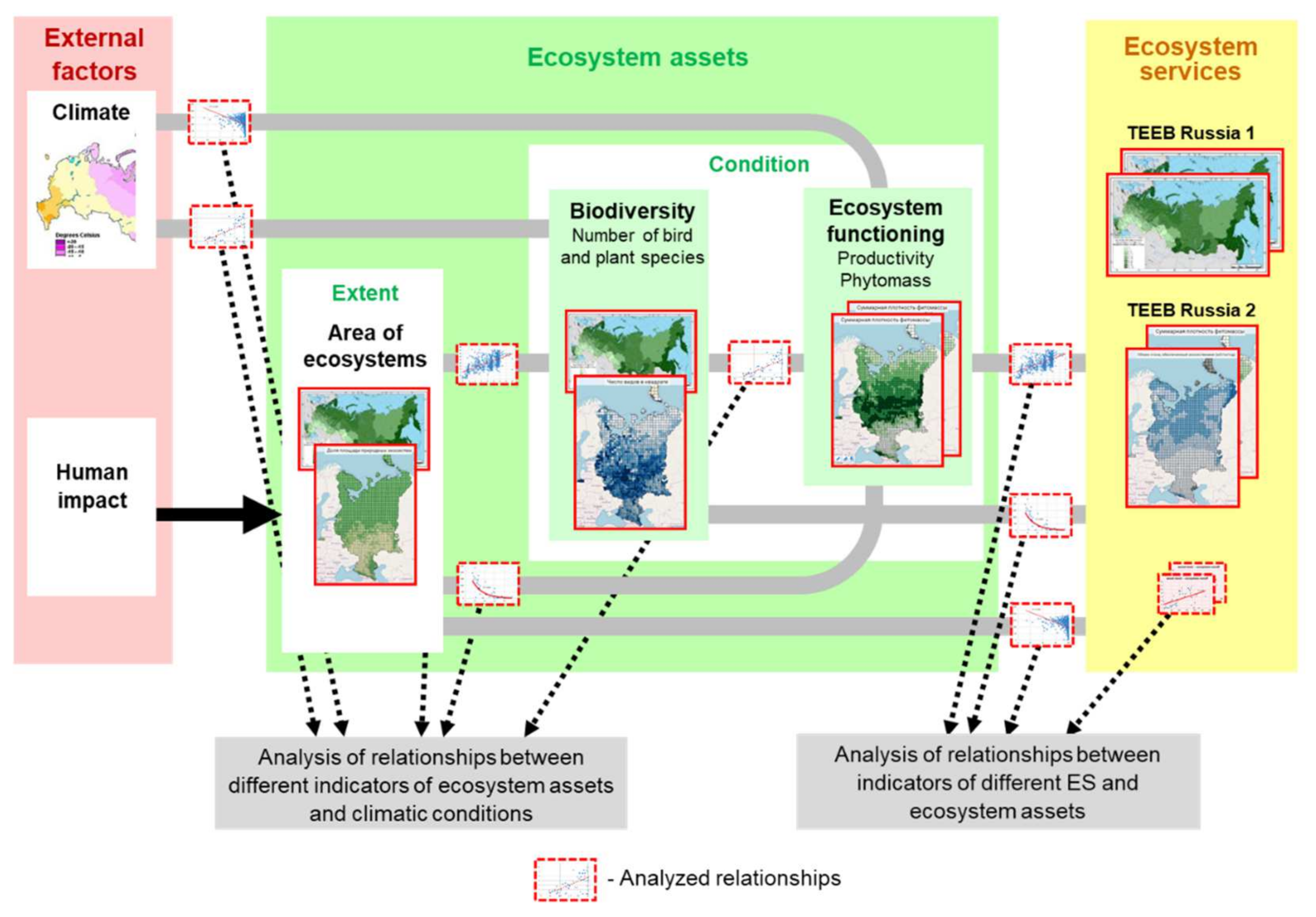
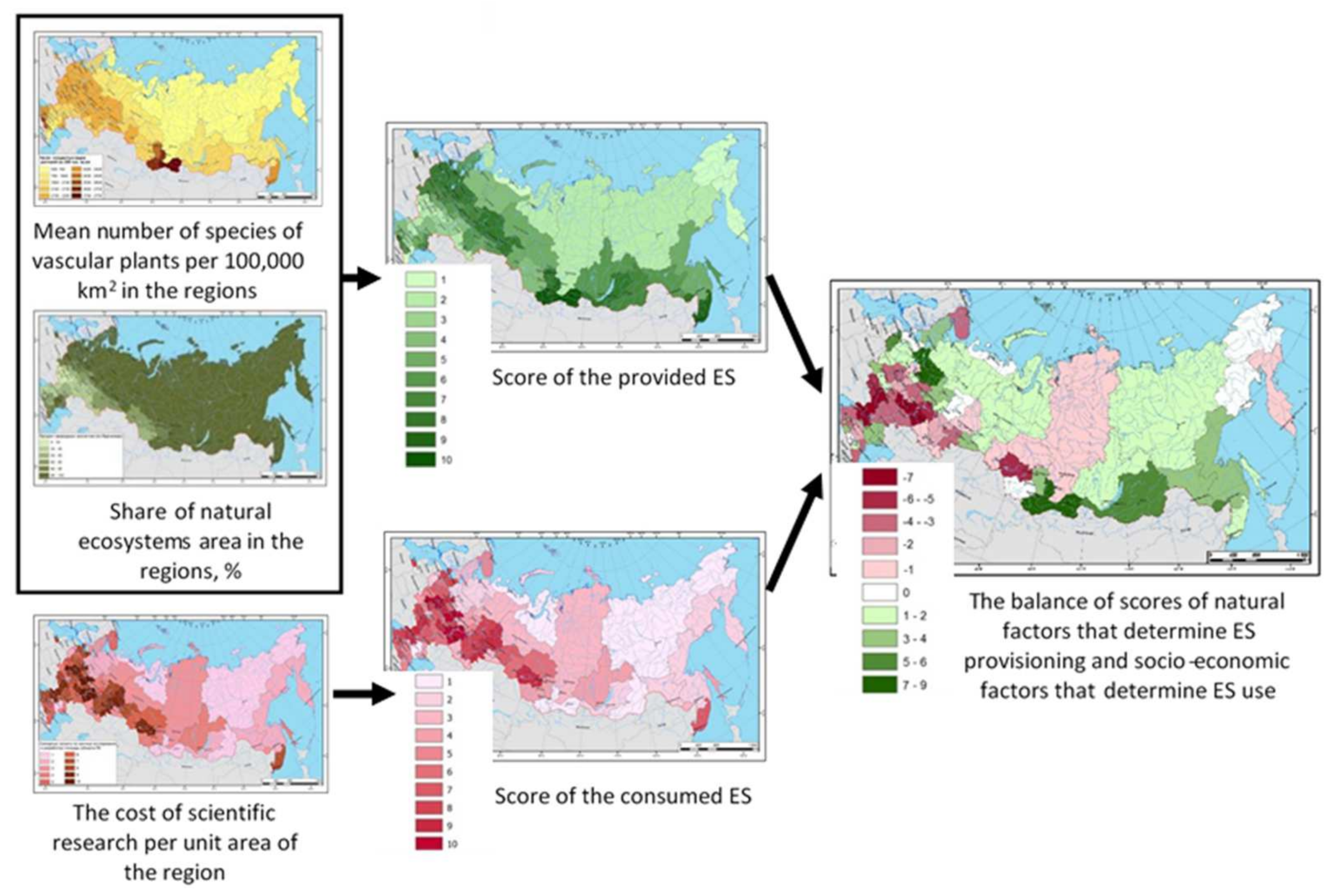
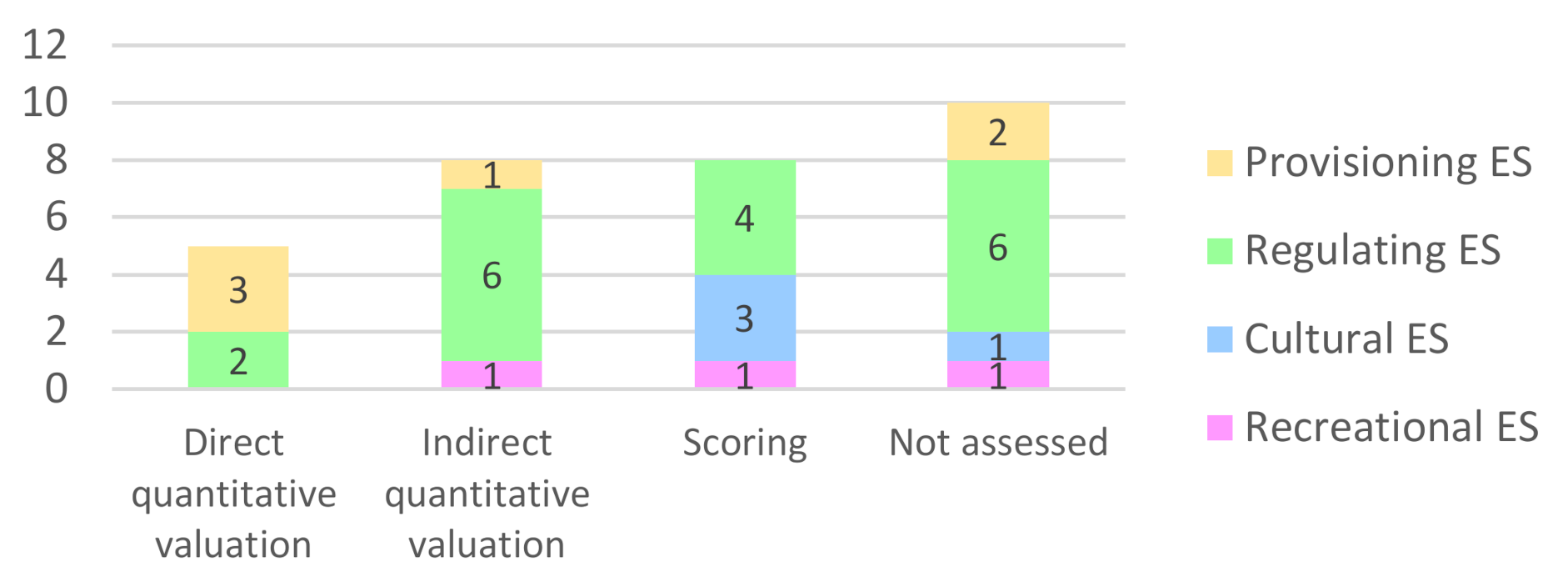
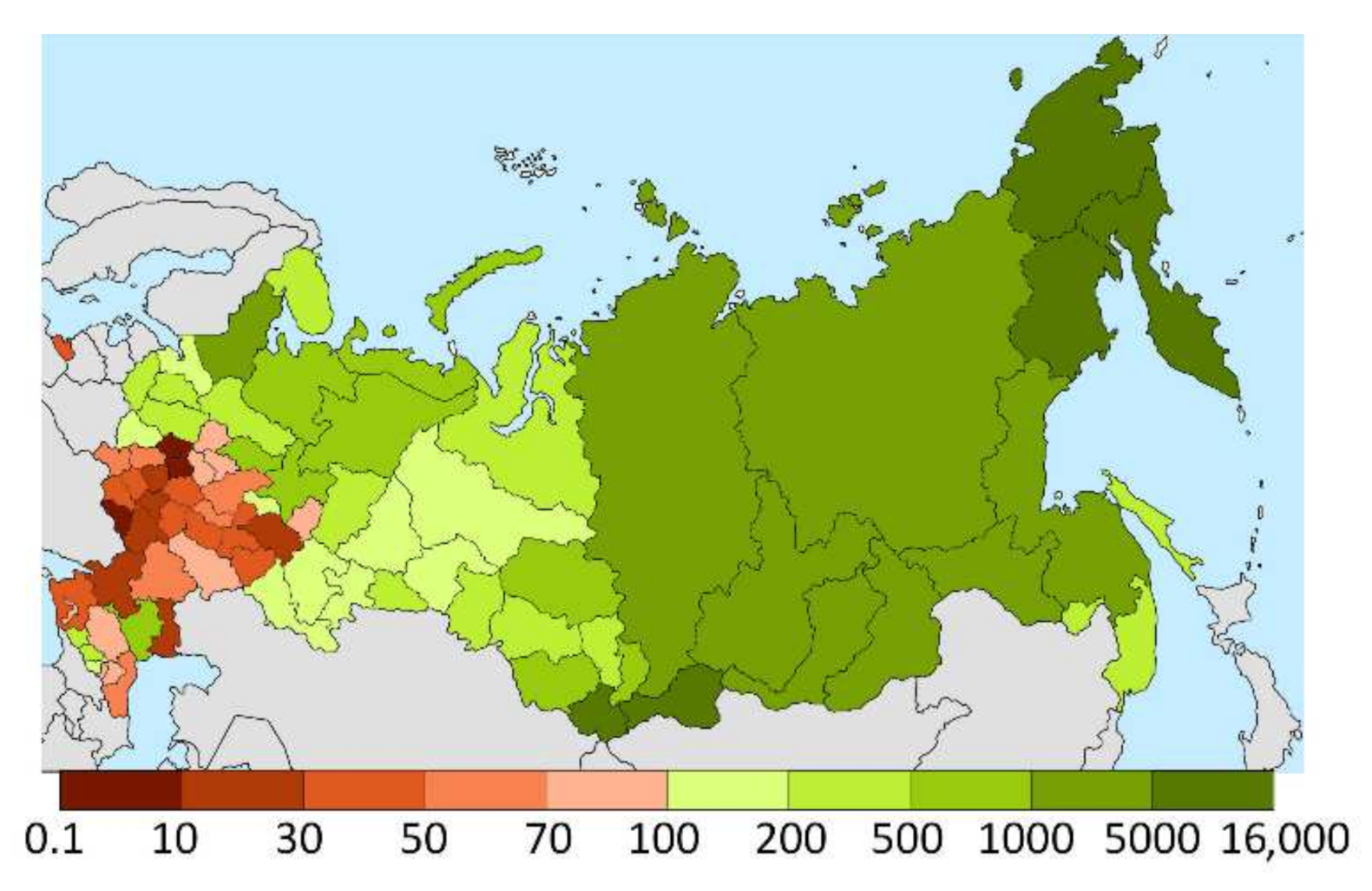
| Main Characteristics | Indicators | Data Sources |
|---|---|---|
| Extent | ||
| Area of ecosystem assets | Area of different types of ecosystems | Vegetation map (regular updates required) Remote sensing data 1 |
| The degree of anthropogenic territory transformation | The share of area of natural ecosystems | Ditto |
| Condition | ||
| Ecosystem functioning | Productivity of ecosystems | Remote sensing data 1 |
| Biomass of ecosystems | Remote sensing data 1 | |
| Data on wood stocks from Forest Cadaster of Federal Forestry Agency | ||
| Diversity of ecosystems | Vegetation map (regular updates required) Remote sensing data 1 | |
| Species diversity | Bird species richness Index of synanthropization of bird population | Atlas of Breeding Birds of the European part of Russia (currently covers only European Russia and should be extended to the rest of the country) |
| Plant species richness | Local surveys on plant species diversity (currently data available for several subjects of the RF, these surveys should be extended to the rest of the country) | |
| Red Data book indices 1 | Number and proportion of Red Data Book species of plants and animals | Red Data Books of subjects of the RF Atlas of Breeding Birds of the European part of Russia |
| Pollution 1 | Air pollution Water pollution Polluted territories | Federal State Statistics Service Federal Service for Hydrometeorology and Environmental Monitoring |
| Ecosystem Services | Provided ES | Consumed ES | Demanded ES |
|---|---|---|---|
| Provisioning ES | |||
| Wood production | Annual allowable cut (m3/ha/year) 1 | Logging volume (m3/ha/year) 1 | Logging volume necessary for regional economy and household welfare 2 |
| Non-wood production of terrestrial ecosystems | Biological stocks of mushrooms and berries (kg/ha) | Mushroom and berry harvest (kg/ha/year) | Harvest of bioresources needed for regional economy and household welfare 2 |
| Production of fodder on natural pastures | Productivity of natural pastures (kg/ha/year of fodder units) | Amount of natural fodder eaten by livestock (kg/ha/year of fodder units) | Amount of natural fodder needed for regional economy and household welfare 2 |
| Game production | Allowable harvest (or total numbers of game animals as a proxy (numbers/ha) 1 | Actual game harvest (numbers/ha/year) 1 | Game harvest necessary for regional economy and household welfare 2 |
| Regulating ES | |||
| Carbon storage | Total carbon content in phytomass and soil (tC/ha) | Carbon stock in managed forests (tC/ha) 1 | Carbon stock necessary for effective climate regulation 2 |
| Regulation of CO2 flows | Carbon balance (tC/ha/year) | Carbon balance of managed forests (tC/ha/year) 1 | Carbon balance necessary for effective climate regulation 2 |
| Air purification by vegetation (absorption of pollutants by suburban forests) | Maximum amount of air-borne pollutants that can be captured by vegetation without significant damage (kg/ha/year) | Amount of air-borne pollution actually captured by vegetation (kg/ha/year) | Toxic gas emissions (kg/ha/year) 1 |
| Regulation of runoff volume by terrestrial ecosystems | Amount (share) of runoff provided by the functioning of terrestrial ecosystems (m3/ha/year) | Use of freshwater (m3/ha/year) 1 | Runoff necessary for regional economy and household welfare 2 |
| Water quality assurance by terrestrial ecosystems | Amount of potentially purified runoff (m3/ha/year) | Amount of purified runoff (m3/ha/year) | Volume of polluted runoff (m3/ha/year) |
| Water quality assurance by freshwater ecosystems | Volume of wastewater potentially diluted and purified to a safe concentration (m3/ha/year) | Volume of purified and diluted wastewater (m3/ha/year) | Discharge of polluted wastewater (m3/ha/year) 1 |
| Soil protection from water erosion | The amount of soil erosion avoided due to terrestrial ecosystems (t/ha) | Economically important share of avoided soil erosion 1 | ES volume required to prevent damage 2 |
| Regulation of cryogenic processes | Change in surface temperature without vegetation and snow cover (°C) | Anthropogenic heating of permafrost (°C) | ES volume required to prevent damage 2 |
| Recreational ES | |||
| Formation of natural conditions for weekend recreation | Number of people who can spend recreational time in the suburban forests on weekends | Actual number of people who can spend recreational time in the suburban forests on weekends 2 | The number of visitors to nature required to ensure the health and well-being of the population 2 |
| ES Group | ES | Productivity | Phytomass | Share of Forest Area, % | Share of Area of Transformed Ecosystems, % | Mean Number of Species in Local Flora | Mean Bird Species Number per Square |
|---|---|---|---|---|---|---|---|
| 1 | Wood production | −0.516 ** | 0.600 ** | 0.581 ** | −0.466 ** | 0.232 | 0.278 * |
| Runoff regulation | −0.644 ** | 0.386 ** | 0.608 ** | −0.593 ** | −0.040 | −0.309 * | |
| Erosion prevention | 0.078 | 0.088 | −0.019 | −0.073 | 0.676 ** | −0.144 | |
| Fodder production | 0.331 * | −0.583 ** | −0.477 ** | 0.133 | 0.237 | −0.325 * | |
| Carbon storage | 0.586 ** | −0.409 ** | −0.458 ** | 0.668 ** | 0.135 | −0.132 | |
| 2 | Pollination | 0.701 ** | −0.161 | −0.514 ** | 0.813 ** | 0.371 ** | 0.312 * |
| Recreation | 0.221 | 0.306 * | −0.002 | 0.140 | 0.485 ** | 0.325 * |
| Indicators of Ecosystem Assets | Average Annual Temperature | Average Annual Precipitation | Share of Area of Transformed Ecosystems, % | Productivity | Phytomass |
|---|---|---|---|---|---|
| Share of area of transformed ecosystems | 0.434 ** | −0.238 | 1 | ||
| Productivity | 0.588 ** | −0.197 | 0.860 ** | 1 | |
| Phytomass | −0.236 | 0.637 ** | −0.400 ** | −0.531 ** | 1 |
| Mean plant species number in local flora | 0.298 * | 0.539 ** | 0.282* | 0.443 ** | 0.102 |
| Mean bird species number per 50 km square | 0.178 | 0.156 | 0.243 | 0.127 | 0.467 ** |
| Operating Indicators | Improved Indicators | Correlation | Direct Management Interpretations of Correlations | Meaning for Real World |
|---|---|---|---|---|
| Productivity | Wood production Runoff regulation | Negative | 1. Primarily to protect less productive ecosystems or reduce the productivity of ecosystems | Wrong Wrong |
| Fodder production Carbon storage Pollination | Positive | 2. Primarily to protect high productive ecosystems or increase productivity of ecosystems | Right/Wrong 1 Wrong Right/Wrong 1 | |
| Phytomass | Wood production Runoff regulation | Positive | 3. Primarily to protect ecosystems with greater phytomass or increase phytomass of ecosystems | Right/Wrong 1 Right/Wrong 1 |
| Fodder production Carbon storage | Negative | 4. Primarily to protect ecosystems with smaller phytomass or decrease phytomass of ecosystems | Wrong Wrong | |
| Species richness | Wood production Prevention of soil erosion Pollination Recreation | Positive | 5. Primarily to protect ecosystems with high species diversity or increase diversity in ecosystems | Right/Wrong 1 Right/Wrong 1 Right/Wrong 1 Right/Wrong 1 |
| Runoff regulation Fodder production | Negative | 6. Primarily to protect ecosystems with low species diversity or reduce diversity in ecosystems | Wrong Wrong | |
| The degree of territory transformation | Carbon storage Pollination Plant species richness | Positive | 7. Primarily to protect more transformed ecosystems or increase the degree of transformation of existing ecosystems | Wrong Wrong Wrong |
| Wood production Runoff regulation | Negative | 8. Primarily to protect less transformed ecosystems or decrease the degree of transformation of existing ecosystems | Right Right |
Publisher’s Note: MDPI stays neutral with regard to jurisdictional claims in published maps and institutional affiliations. |
© 2021 by the authors. Licensee MDPI, Basel, Switzerland. This article is an open access article distributed under the terms and conditions of the Creative Commons Attribution (CC BY) license (https://creativecommons.org/licenses/by/4.0/).
Share and Cite
Bukvareva, E.; Grunewald, K.; Klimanova, O.; Kolbovsky, E.; Shcherbakov, A.; Sviridova, T.; Zamolodchikov, D. TEEB-Russia: Towards National Ecosystem Accounting. Sustainability 2021, 13, 6678. https://doi.org/10.3390/su13126678
Bukvareva E, Grunewald K, Klimanova O, Kolbovsky E, Shcherbakov A, Sviridova T, Zamolodchikov D. TEEB-Russia: Towards National Ecosystem Accounting. Sustainability. 2021; 13(12):6678. https://doi.org/10.3390/su13126678
Chicago/Turabian StyleBukvareva, Elena, Karsten Grunewald, Oxana Klimanova, Evgeni Kolbovsky, Andrey Shcherbakov, Tatiana Sviridova, and Dmitry Zamolodchikov. 2021. "TEEB-Russia: Towards National Ecosystem Accounting" Sustainability 13, no. 12: 6678. https://doi.org/10.3390/su13126678
APA StyleBukvareva, E., Grunewald, K., Klimanova, O., Kolbovsky, E., Shcherbakov, A., Sviridova, T., & Zamolodchikov, D. (2021). TEEB-Russia: Towards National Ecosystem Accounting. Sustainability, 13(12), 6678. https://doi.org/10.3390/su13126678






